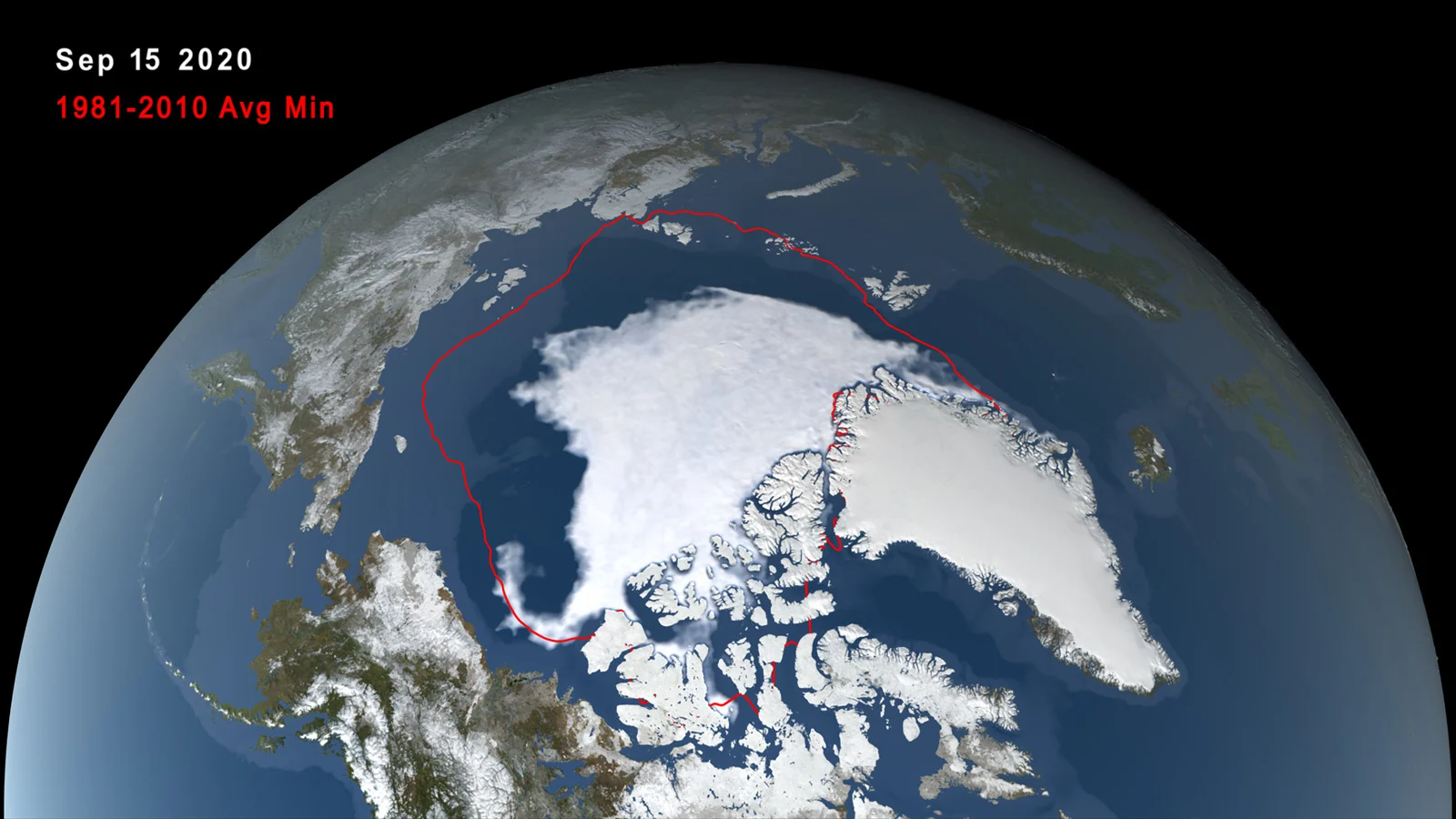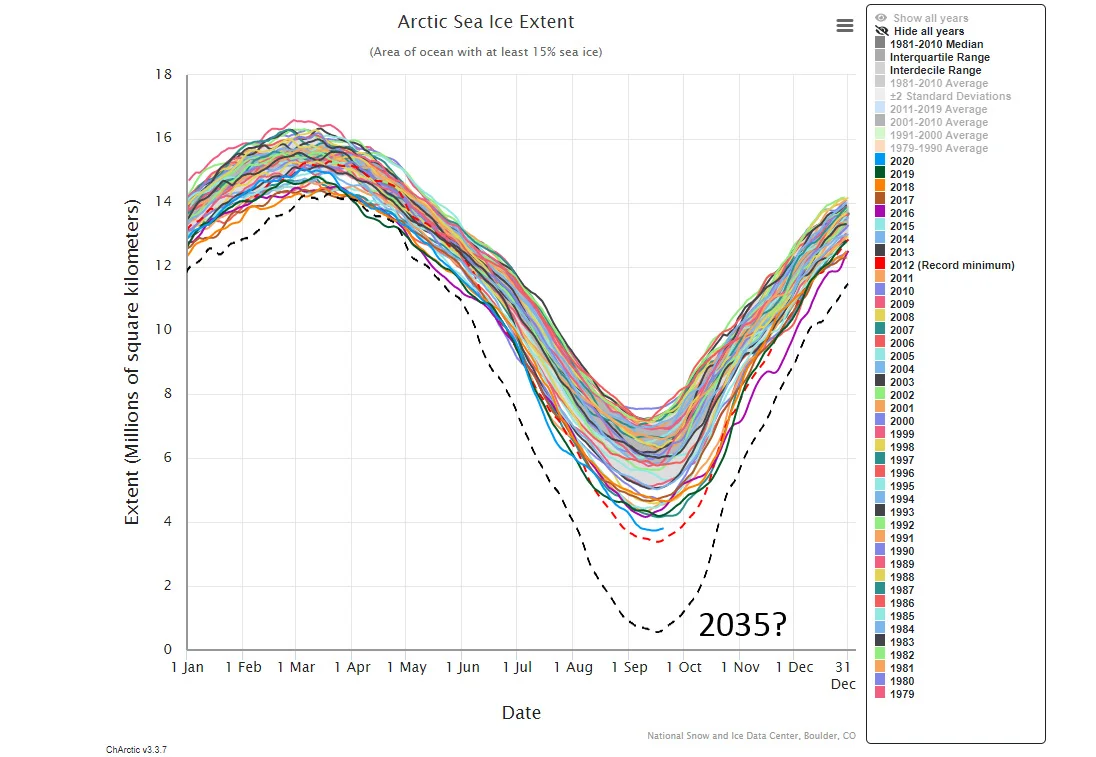
Arctic Sea Ice melts away to 2nd lowest minimum on record
There are signs now of a new Arctic climate emerging, where extremes have become routine
Arctic sea ice reached its summer minimum for 2020 in mid-September, which is now logged as the 2nd lowest extent seen in over 40 years.
Each year, as the seasons wax and wane, sea ice across the Arctic Ocean spreads to a maximum extent in March or April and then melts down to a minimum typically in mid-to-late September. In 2020, with reports of Arctic heat waves and expansive Siberian wildfires, the summer melt season saw sea ice disappearing at an unprecedented rate.
As of September 15, the U.S. National Snow and Ice Data Center (NSIDC) recorded Arctic sea ice at an extent of 3.74 million square kilometres. That's over 2.6 million square kilometres lower than the average extent seen between 1981 and 2010. It is also only 350,000 square kilometres shy of the extreme record low extent seen in 2012. According to the NSIDC, this 2020 minimum extent is now the second-lowest extent in the nearly 42-year satellite record.
According to NASA, 2020 is also only the second time on record that the minimum extent has fallen below 4 million square kilometres.

Data from the National Snow and Ice Data Center puts the 2020 Arctic Sea Ice minimum extent at the 2nd lowest on record. Credit: NSIDC/Scott Sutherland
"It's been a crazy year up north, with sea ice at a near-record low, 100-degree (Fahrenheit) heat waves in Siberia, and massive forest fires," Mark Serreze, director of NSIDC, said in a statement on Monday. "The year 2020 will stand as an exclamation point on the downward trend in Arctic sea ice extent. We are headed towards a seasonally ice-free Arctic Ocean, and this year is another nail in the coffin."
This near-record low extent also represents a loss of more multiyear ice in the Arctic.
"As the sea ice cover extent declines, what we're seeing is we're continuing to lose that multiyear ice," Serreze told NASA. "The ice is shrinking in the summer, but it's also getting thinner. You're losing extent, and you're losing the thick ice as well. It's a double whammy."
ARCTIC'S LARGEST ICE SHELF IS AT RISK
The extreme heat in the Arctic is not only impacting sea ice, though. Greenland's glaciers are also suffering under these conditions. As was already reported earlier, the island's ice sheet may have already passed a point of no return for melting.

The red area in this optical satellite image highlights Djimphna Sund, in northern Greenland, where a 113 square kilometre chunk of ice has broken away from Spalte Glacier (part of Nioghalvfjerdsfjorden Glacier). Source: Copernicus Sentinel data modified by G.E. US.
A little over a month ago, satellites recorded a significant chunk of the Spalte Glacier breaking off into Djimphna Sund, in northern Greenland. This section of the ice shelf has been measured at 113 square kilometres in area. According to the Geological Survey of Denmark and Greenland, this ice shelf has lost 160 square kilometres since 1999.
"We should be very concerned about what appears to be progressive disintegration at the Arctic's largest remaining ice shelf, because upstream it is the only major Greenland ice sheet ice stream, draining 16 per cent of the inland ice reservoir," Jason Box, a professor in glaciology at the Geological Survey of Denmark and Greenland (GEUS), said in a statement.

This sequence of satellite images shows the Spalte Glacier from 2013 to 2020, when a 113-square-kilometre chunk of the ice shelf broke away into Greenland's Djimphna Sund. Credits: EU Copernicus and GE U.S.
"Temperatures in the Arctic are rising faster than the global average. More heat is available from air and ocean to melt away the bottom and surface of ice shelves, and the thinning ice shelves are more susceptible to breaking up," says Dr. Niels J. Korsgaard, a researcher at GE U.S. "We saw this with Zachariae Glacier, this summer with Milne Ice Shelf in Canada, and now Nioghalvfjerdsfjorden Glacier is losing parts of its ice shelf as well."
RELATED: CANADA'S LAST INTACT ICE SHELF BROKE APART THIS SUMMER
ICE-FREE SUMMERS BY 2035?
The toll of Arctic warming is causing researchers to revise their estimates of when we will see the first ice-free summers in the Arctic.
"Not so long ago, I heard that we had 100 years before the Arctic would be ice free in the summer," said 'ice pilot' Paul Ruzycki, according to the Associated Press. "Then I heard 75 years, 25 years, and just recently I heard 15 years. It's accelerating."
The most recent estimate Ruzycki refers to is likely based on research published in January, in the journal Climate. Another study, published in Nature Climate Change in August, had similar results. Updated climate models show that we could see the first ice-free summers in the Arctic as early as the mid-2030s.

This speculative graph shows what sea ice extent in the Arctic could look like in 2035 if these projections play out. Credit: NSIDC/Scott Sutherland
For this purpose, ice-free means that the September minimum extent for Arctic sea ice drops to below 1 million square kilometres. In such a case, sea ice would still spread to cover a wide expanse of the Arctic Ocean in northern winter and early spring. The only ice remaining from that during the summer minimum, however, would be in the waters around the Canadian Arctic Archipelago, and along the Alaskan and Greenland shorelines. The central Arctic Ocean would be completely open.
NEW ARCTIC EMERGING?
Based on the latest research, published in Nature Climate Change last week, these changes are so profound, that we may be seeing the emergence of a new Arctic climate.
According to the study, "this work suggests that the Arctic is already transitioning from a cryosphere-dominated system. Changes in sea ice at the end of the twentieth century are substantial, and if emissions follow an RCP 8.5-like path, this region is likely to experience extremes in temperature, sea ice and precipitation phase far outside anything experienced in the past century and probably much longer."
The 'RCP 8.5-like path' mentioned by the researchers is also known as the 'business-as-usual' or 'worst-case scenario' for greenhouse gas emissions. This is what we will see if we continue to burn fossil fuels at an increasing rate. Under these conditions, the ice-age Arctic we've seen up until recently ("cryosphere-dominated") would transition to more of a warm-weather climate, with less ice and snow, and more rainfall.
Even now, the research is showing how the Arctic is experiencing extremes, in sea ice loss, rainfall and heat, that are out of the ranges seen in the recent past. Thus, climatologists are having to plumb data going back millennia, instead, to find useful comparisons.
"The new climate can't be predicted by the previous climate," Lisa Landrum, the lead author of this study from the National Center for Atmospheric Research (NCAR), told the Associated Press. "The year-to-year variability, the change in many of these parameters, is moving outside the bounds of past fluctuations."
Sources: NSIDC | NASA | CBC/Associated Press | Bloomberg












